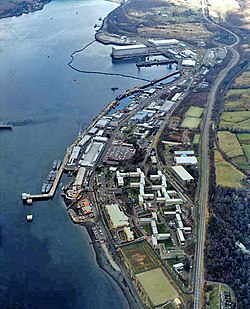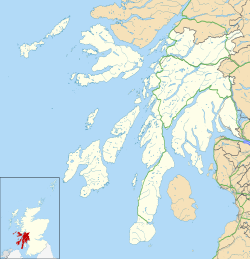HMNB Clyde
Operating base in Scotland for the Royal Navy From Wikipedia, the free encyclopedia
His Majesty's Naval Base, Clyde (HMNB Clyde; also HMS Neptune), primarily sited at Faslane on the Gare Loch, is one of three operating bases in the United Kingdom for the Royal Navy (the others being HMNB Devonport and HMNB Portsmouth). It is the navy's headquarters in Scotland and is best known as the home of Britain's nuclear weapons, in the form of nuclear submarines armed with Trident missiles.
| HMNB Clyde | |
|---|---|
| Gare Loch, Argyll and Bute, Scotland | |
 An aerial view of HMNB Clyde | |
Location in Argyll and Bute | |
| Coordinates | 56°03′58″N 04°49′03″W |
| Type | Naval base |
| Area | 87 hectares (210 acres) |
| Site information | |
| Owner | Ministry of Defence |
| Operator | Royal Navy |
| Controlled by | Naval Base Commander, Clyde |
| Condition | Operational |
| Website | HMMB Clyde - Royal Navy |
| Site history | |
| Built | 1940s |
| In use | 1940s – present |
| Garrison information | |
| Current commander | Commodore Sharon Malkin: December 2022 - Present[1] |
| Garrison | Submarine Service |
History
Faslane was first constructed and used as a base in the Second World War. During the 1960s, the British Government began negotiating the Polaris Sales Agreement with the United States regarding the purchase of a Polaris missile system to fire British-built nuclear weapons from five specially constructed submarines. In the end, only four were constructed; HMS Resolution, HMS Repulse, HMS Renown and HMS Revenge. These four submarines were permanently based at Faslane.[2]
Faslane itself was chosen to host these vessels at the height of the Cold War because of its geographic position, which forms a bastion on the relatively secluded but deep and easily navigable Gare Loch and Firth of Clyde on the west coast of Scotland. This position provides for rapid and stealthy access through the North Channel to the submarine patrolling areas in the North Atlantic, through the GIUK gap to the Norwegian Sea. At the time it was chosen, the location was also close to the American SSBN base at Holy Loch, which operated 1961–1992. One boat was always on patrol at any given time.[3]
In 1971, the base was home to the 3rd Submarine Squadron of Nuclear Fleet and Diesel Patrol Submarines, "the fighters", and the 10th Submarine Squadron consisting of the four Polaris submarines, "the bombers".[4]
In Command
Based vessels and units
The following notable vessels and units are based at Faslane.[5][6][7][8][9]
Royal Navy
Commodore J. L. Perks OBE, Commander Submarine Flotilla/(Commodore Submarine Service (COSM))[10]
- Vanguard-class SSBNs
- Astute-class SSNs
- Sandown-class mine countermeasures vessel
- HMS Bangor – forward deployed with 9 Mine Countermeasures Squadron at HMS Jufair, Bahrain
- Faslane Patrol Boat Squadron
- HMS Tracker (Archer-class patrol vessel)
- HMS Raider (Archer-class patrol vessel)
- Northern Diving Group
- Mine Threat and Exploitation Group
- Arcims-class autonomous vessels
- RNMB Hebe
- RNMB Hydra
- RNMB Hussar
- RNMB Hazard
- RNMB Harrier (forward deployed with 9 MCM Squadron at HMS Jufair, Bahrain as of 2023)[13]
- RNMB Halcyon[14][15]
- RNMB Hellcat (mine warfare support boat)[16][17]
- Arcims-class autonomous vessels
Royal Fleet Auxiliary
- RFA Stirling Castle (from Spring 2024 as "mothership" of autonomous vessels from Mine Threat and Exploitation Group)[18][19]
Royal Marines (UK Commando Force)
- 43 Commando Fleet Protection Group
- Headquarters Squadron
- O Rifle Squadron
- P Rifle Squadron
- R Rifle Squadron
- Island-class patrol vessels
- Mull
- Rona
- Eorsa
Serco Marine Services
- Multicat 2613-class utility boat
- SD Angeline
- Coastal oilers
- SD Oilman
- SD Waterpress
- Impulse-class tugs
- SD Impulse (A344)
- SD Impetus (A345)
- ATD 2909-class tugs
- SD Reliable
- SD Resourceful
- SD Dependable
- STAN 2608-class tugs
- SD Jupiter
- Oban-class tenders
- SD Oronsay
- SD Omagh
- Personnel ferries
- SD Eva
- STAN 1505-class tenders
- SD Clyde Racer
- STAN 1905-class tenders
- SD Clyde Spirit
Ministry of Defence Police
- Clyde Marine Unit
- Island-class patrol vessels
- Iona
- Skye
- Lismore
- Barra
- Harris
- Jura
- Island-class patrol vessels
- Nuclear Division (Faslane Station)
- Central Support Group
Role and operations


HMNB Clyde lies on the eastern shore of Gare Loch in Argyll and Bute, to the north of the Firth of Clyde and 25 mi (40 km) west of Glasgow. The submarine base encompasses a number of separate sites, the primary two being:
- Faslane, 25 miles from Glasgow;
- RNAD Coulport, beside Loch Long, 2 mi (3.2 km) west of Faslane.
Faslane is also a Defence Equipment and Support site, operated in dual site organisation with Great Harbour, Greenock, by Babcock Marine and Technology,[20] and managed by Serco Denholm.[21][22][23]

The naval shore establishment at Faslane is HMS Neptune. Naval personnel appointed to the base who do not belong to a seagoing vessel make up Ship's Company. Both the Gareloch and Loch Long are sea lochs extending northwards from the Firth of Clyde. The base serves as home base to Britain's fleet of Vanguard-class nuclear-powered and nuclear-armed submarines, as well as conventionally armed nuclear-powered submarines, supported by the 43 Commando Fleet Protection Group Royal Marines.[24]
In command of HMNB Clyde is the Naval Base Commander (Clyde), Commodore Sharon Malkin. The base is home to a number of lodger units including Flag Officer Scotland and Northern Ireland (FOSNI) (who is also Rear Admiral Submarines), the Northern Diving Group and the Scottish Headquarters of the Ministry of Defence Police. It is base to 3,000 service personnel, 800 of their families and 4,000 civilian workers, largely from Babcock Marine, forming a major part of the economy of Argyll and Bute and West Dunbartonshire.[25]
In 2018, the Secretary of State for Scotland at the time, David Mundell said: "The UK’s entire submarine fleet will be based at Faslane by 2020. This will reinforce Scotland’s vital role in protecting our country, and guarantee skilled, secure jobs on the Clyde for years to come."[26]
Safety and accidents at Faslane
Exercise Evening Star is the annual test of the emergency response routines to a nuclear weapon accident at Faslane. It is conducted by the Office for Nuclear Regulation. In 2011 the test failed as "a number of command and control aspects of the exercise were not considered to have been adequately demonstrated".[27]
In 2013–14 there were 99 radiation accidents concerning nuclear reactors, and 6 with nuclear weapons. These are the highest numbers for at least six years. The MoD maintains that there was no risk to the public as most of them were minor accidents. The SNP defence spokesman, Angus Robertson, called the figures "totally shocking".[28]
The MoD, however, argued that it was "entirely misleading" to focus only on the number of incidents, because they include "very minor issues such as the failure to fill out the correct form before painting works began." Indeed, the MOD stated that this "rigorous system shows how seriously MoD takes all aspects of nuclear safety, ensuring lessons are learned, and we can be clear that none of the events in the reports posed any risk to the health of our personnel, or to any members of the public." Indeed, one of the recorded events was the incorrect labelling of an empty pallet. Minor events were reported and investigated so that performance could be continuously improved. "This comprehensive, independent recording process allows Clyde to maintain a robust reporting culture, undertake learning from experience and to take early corrective action," the UK Defence Minister, Philip Dunne, told MPs.[29]
Anti-nuclear demonstrations
Wikinews has related news:
Given the presence of these nuclear capable missiles, Faslane has attracted demonstrations by Campaign for Nuclear Disarmament and other Scottish pressure groups, including Trident Ploughshares. Since 1982, a permanent peace camp is outside the base gates, where there are frequent demonstrations and regular Wednesday protests. The presence of Faslane is also an issue in Scottish politics.[30]
The Scottish National Party (SNP), the Scottish Socialist Party (SSP), and the Scottish Greens all oppose the deployment of nuclear weapons although the SNP have made assurances that they would retain the base for the servicing of conventionally armed and conventionally powered naval units. Members of those parties and indeed some from the Labour Party are often present at rallies. Also, some former independents, such as George Galloway attend rallies outside Faslane.[31]

Faslane 365
The Faslane 365 campaign was a one-year protest at the base. It was a civil resistance initiative to apply critical public pressure for the disarmament of Britain's nuclear weapons.[32]
The campaign was launched in September 2006, with the first protest action commencing on 1 October 2006 carried out by a campaigning group of women associated with protests at Greenham Common. It formally ended with a "Big Blockade" on 1 October 2007.[33]
131 blockading groups took part in Faslane 365 and 1150 arrests were made.[32]
See also
References
External links
Wikiwand in your browser!
Seamless Wikipedia browsing. On steroids.
Every time you click a link to Wikipedia, Wiktionary or Wikiquote in your browser's search results, it will show the modern Wikiwand interface.
Wikiwand extension is a five stars, simple, with minimum permission required to keep your browsing private, safe and transparent.


